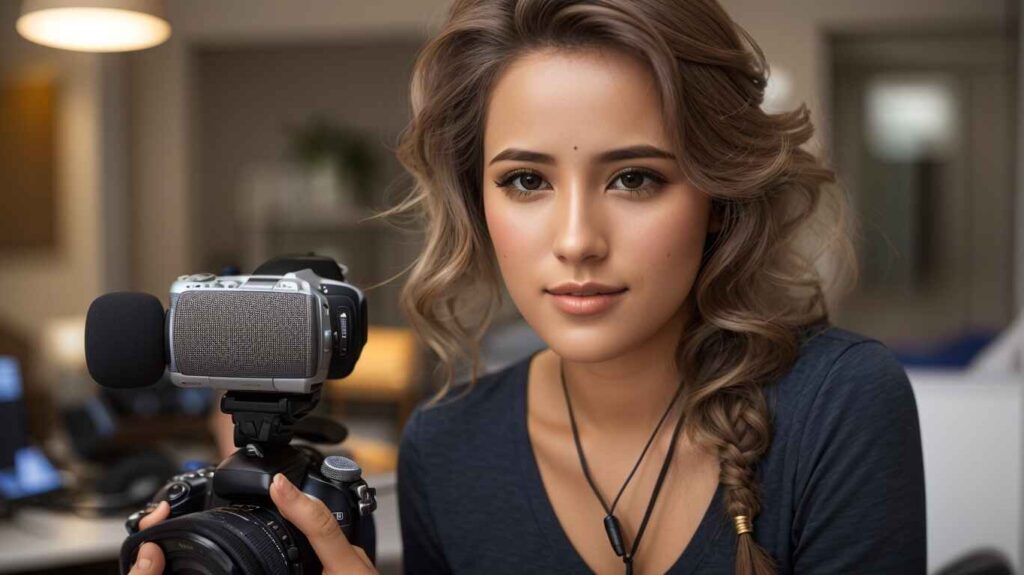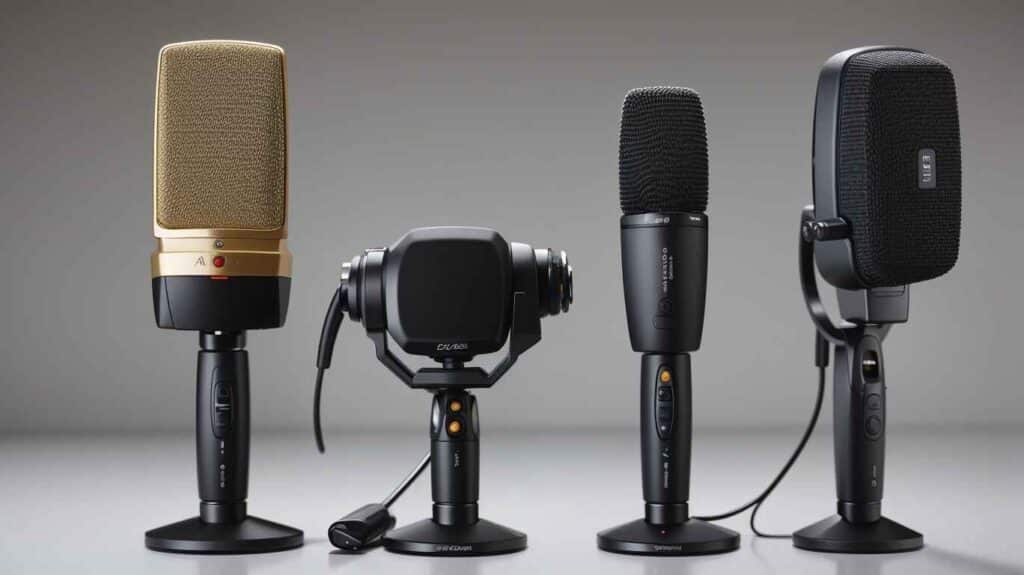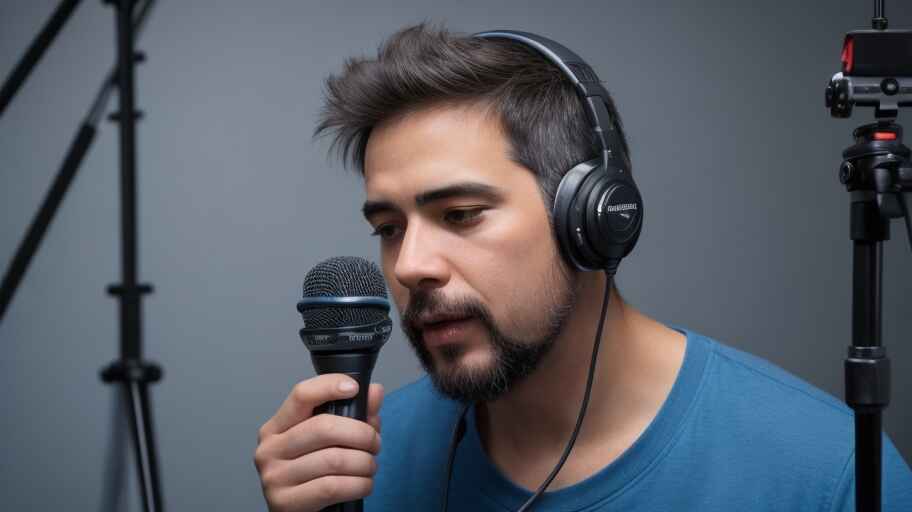Can You Use An External Microphone With A D7000? Well, if you’ve ever tried recording audio on your trusty Nikon D7000 and ended up with that dreaded wind noise or muffled voices, you’re in for a treat!
In this article, we’re about to unravel the secret to crystal-clear audio magic with your D7000.
So grab your popcorn, or should I say, pop filter, because we’re diving into the world of external microphones that’ll make your camera sound as good as it looks!
Can You Use An External Microphone With A D7000?

Yes, it is possible to use an external microphone with the Nikon D7000. The camera has a 3.5mm microphone jack, and users have reported success using external microphones with the camera.
To use an external microphone, simply plug it into the microphone jack on the camera. It is also possible to adjust the microphone level settings for both internal and external microphones from the shooting menu.
To learn more about using an external mic with Nikon P900, don’t miss this informative article on Best Quick Reviews: Can An External Microphone Be Connected To A Nikon P900?
What is the built-in microphone capability of the Nikon D7000?
Before we explore the world of external microphones, let’s take a moment to understand the built-in microphone capability of the Nikon D7000. The D7000 comes equipped with a built-in stereo microphone that can capture audio while recording videos.
While this microphone is sufficient for basic recording needs, it may not provide the level of audio quality and versatility that many videographers and content creators desire.
Does the camera have a dedicated port for external microphones?
Yes, the Nikon D7000 has a dedicated port for external microphones. This port, typically labeled as a “microphone input” or “mic in,” allows you to connect an external microphone to the camera.
This is where the magic happens, as external microphones can significantly improve the audio quality of your recordings.
Types of External Microphones Compatible with D7000

There are various types of external microphones that you can use with your Nikon D7000, each catering to different recording scenarios. Let’s explore some of the most common options:
Shotgun Microphones
Shotgun microphones are highly directional microphones that capture audio from a narrow angle, reducing ambient noise and focusing on the subject. They are ideal for capturing clear audio in noisy environments or when the subject is at a distance.
Lavalier Microphones
Lavalier microphones, also known as lapel microphones, are small and discreet. They can be clipped onto the clothing of the subject, making them perfect for interviews and presentations.
Condenser Microphones
Condenser microphones are known for their sensitivity and ability to capture detailed audio. While they are often used in studio settings, they can be a valuable addition to your D7000 setup for capturing high-quality sound.
Wireless Microphone Systems
Wireless microphone systems allow you to capture audio from a distance without the hassle of cables. They are popular among content creators who need mobility during their shoots.
Compatibility Considerations for Specific Microphone Models
When choosing an external microphone for your Nikon D7000, it’s essential to consider compatibility. Not all microphones will work seamlessly with your camera. Some microphones may require additional adapters or power sources.
It’s crucial to research and ensure that the microphone you choose is compatible with your camera model.
How to Physically Connect a Microphone to a D7000?

Now that you’ve selected the right microphone for your needs, let’s talk about how to physically connect it to your D7000:
- Locate the Microphone Input: As mentioned earlier, the D7000 has a dedicated microphone input port. It is usually located on the side of the camera body. Identify this port before proceeding.
- Choose the Correct Cable: Depending on your microphone and its connector type, you may need a specific cable to connect it to the camera. Ensure you have the right cable on hand.
- Connect the Microphone: Gently insert the microphone plug into the camera’s microphone input port. Make sure it’s securely connected to prevent any loose connections.
- Secure the Cable: Once connected, secure the microphone cable to the camera or your tripod to prevent it from getting tangled or accidentally pulled during recording.
Now that your microphone is physically connected, let’s move on to adjusting settings for optimal audio recording.
To stay informed about Connect Coolpix P610 To External Microphone, this article on Best Quick Reviews is essential: How To Connect Coolpix P610 To External Microphone?
Adjusting Settings for External Microphone Use
To make the most of your external microphone, you’ll need to adjust some settings on your Nikon D7000. Here’s what you need to do:
- Access the Menu: Turn on your camera and access the menu.
- Select the Audio Settings: Navigate to the audio settings within the menu.
- Choose the External Microphone Option: Select the option that indicates external microphone use. This setting will ensure that the camera records audio from the external microphone instead of the built-in microphone.
- Set Audio Levels: Adjust the audio levels to your desired settings. You may need to do some test recordings to find the perfect level that captures clear sound without distortion.
Common Pitfalls and How to Troubleshoot Them
While using an external microphone with your D7000 can significantly improve audio quality, there are some common issues you may encounter:
- No Audio: If you’re not getting any audio from your external microphone, double-check the connection and ensure the microphone is powered if required.
- Audio Distortion: If your audio sounds distorted or crackly, you may be recording at too high a volume. Adjust the audio levels until the distortion disappears.
- Background Noise: External microphones are sensitive, so be mindful of background noise. Use a windscreen or foam cover to minimize wind noise, and choose a quiet location when possible.
Testing Audio Quality with an External Microphone
Before embarking on your recording journey, it’s essential to test the audio quality with your external microphone. Here’s how to do it:
- Perform a Test Recording: Record a short sample using your external microphone in the same conditions you plan to use it for your main recording.
- Listen Carefully: Play back the recording and listen carefully. Ensure that the audio is clear and free from any issues.
- Make Adjustments: If you notice any issues, such as background noise or distortion, make the necessary adjustments to your microphone placement, settings, or recording environment.
Monitoring Audio Levels During Recording
Monitoring audio levels in real-time is crucial for ensuring the quality of your recordings. Here are some tools and techniques to help you with this:
- Headphones: Use a pair of headphones connected to the camera’s headphone jack to monitor the audio as you record. This allows you to detect any issues immediately.
- Audio Meters: Many cameras, including the D7000, have built-in audio meters that display the current audio levels. Keep an eye on these meters to ensure your audio remains in the optimal range.
Understanding Microphone Accessories for D7000
When it comes to recording audio with your Nikon D7000 using an external microphone, there’s more to it than just the microphone itself.
To truly elevate your audio quality and recording capabilities, it’s essential to understand and utilize microphone accessories. In this section, we’ll provide an overview of some key accessories and explain how they can enhance your microphone’s performance.
Windshields
Windshields, also known as foam windscreens or dead cats, are essential accessories for outdoor recording.
They serve the crucial purpose of reducing wind noise and unwanted air vibrations that can distort your audio. When recording in breezy conditions, using a windshield can make a significant difference in the clarity of your audio.
Extension Cables
Extension cables are handy accessories when you need to position your microphone at a distance from your camera.
They come in various lengths and connector types, allowing you to place your microphone where it’s needed without compromising on audio quality. Extension cables provide flexibility in your setup, especially in situations where you can’t be close to your camera.
Mounts and Shock Mounts
Mounts and shock mounts are designed to hold your microphone securely and isolate it from vibrations and handling noise.
They are particularly useful for reducing unwanted noise caused by camera movements or handling the microphone.
Shock mounts, in particular, provide a suspended support system that absorbs shocks and vibrations, resulting in cleaner audio recordings.
How These Accessories Enhance the Performance of an External Microphone
These accessories enhance your external microphone’s performance by addressing common challenges in audio recording:
- Reducing Wind Noise: Windshields help eliminate the disruptive noise caused by wind, ensuring that your recordings remain clear and distortion-free, even in outdoor environments.
- Extended Reach: Extension cables allow you to position your microphone strategically, capturing audio from various angles or distances, without compromising on quality.
- Minimizing Handling Noise: Mounts and shock mounts prevent vibrations and handling noise from reaching the microphone, resulting in cleaner and more professional-sounding recordings.
Tips for Improving Audio Quality with Accessories
Now that you understand the importance of microphone accessories let’s explore some practical tips for maximizing audio quality using these accessories:
Properly Install Windshields
When using a windshield, make sure it’s securely fitted over the microphone. Ensure there are no gaps or loose areas where wind could sneak in.
Additionally, choose a windshield that matches the size of your microphone to provide optimal protection.
Select the Right Extension Cable
Choose an extension cable that is long enough for your needs but not excessively so.
Longer cables can introduce signal degradation, so opt for the shortest cable that allows you to place the microphone where it’s needed.
Invest in Quality Mounts and Shock Mounts
Not all mounts and shock mounts are created equal. Invest in high-quality options that provide excellent isolation and stability.
Cheap mounts can sometimes transmit vibrations instead of isolating them.
DIY Solutions for Enhancing Audio Recording
If you’re on a budget, there are some DIY solutions that can enhance your audio recording without breaking the bank.
For example, you can create your windshields using foam or fur fabric. Just ensure they fit snugly over your microphone to be effective.
Dealing with Audio Interference and Distortion
Despite your best efforts, you may encounter interference and distortion when using an external microphone with the D7000.
Let’s explore common causes and a step-by-step troubleshooting guide to address these issues.
Common Causes of Interference and Distortion
- Electromagnetic Interference (EMI): EMI from electronic devices or power sources can introduce unwanted noise into your recordings.
- Cable Issues: Damaged or low-quality cables can lead to signal loss, interference, or distortion.
- Microphone Sensitivity: Some microphones are more susceptible to interference than others due to their sensitivity levels.
Step-by-Step Troubleshooting Guide
- Check Cable Quality: Ensure you’re using high-quality, undamaged cables. Swap out any suspect cables to see if the issue resolves.
- Isolate Electronic Devices: Move away from electronic devices that could be causing interference. This includes Wi-Fi routers, fluorescent lights, and other electronic equipment.
- Adjust Microphone Sensitivity: If your microphone allows for sensitivity adjustments, try lowering it to see if it reduces interference.
- Use Ferrite Cores: Consider using ferrite cores on your cables to suppress electromagnetic interference.
- Change Microphone Position: Experiment with moving the microphone to different locations to see if the interference lessens.
Addressing Compatibility Issues with Certain Microphone Models
While the Nikon D7000 is compatible with many external microphones, there can still be compatibility challenges with specific models.
Here, we’ll discuss some common issues and potential workarounds.
Specific Microphone Models
Certain microphones may not work seamlessly with the D7000 due to differences in power requirements or connector types.
It’s crucial to research and ensure compatibility before purchasing a microphone.
Workarounds and Solutions
- Adapter Cables: If your microphone has a different connector type, you can often find adapter cables to match it with the D7000’s microphone input.
- External Power: Some microphones require external power sources. Ensure you have the necessary batteries or power supply for your microphone.
- Compatibility Tests: Before important recordings, conduct compatibility tests to identify any issues in advance.
Leveraging Advanced Features of External Microphones
Many external microphones come with advanced settings and features that can elevate your audio recording quality.
Let’s explore how to utilize these features for professional-grade recordings.
Directional Patterns
Some microphones offer selectable directional patterns (e.g., cardioid, omnidirectional). Choose the pattern that suits your recording environment.
Cardioid patterns are great for isolating sound sources, while omnidirectional patterns capture audio from all directions.
Gain Control
Microphones with gain control allow you to adjust the microphone’s sensitivity. This can be useful for fine-tuning audio levels and preventing distortion.
High-Pass Filters
High-pass filters help reduce low-frequency noise such as vibrations or rumble. Activate this feature when recording in environments with unwanted low-frequency noise.
Incorporating External Audio Recorders with D7000
Using an external audio recorder in conjunction with your Nikon D7000 can offer numerous benefits in terms of audio quality and flexibility. Here are techniques to make the most of this setup:
Benefits and Considerations
- Improved Audio Quality: External audio recorders often provide superior audio quality compared to the D7000’s built-in recording capabilities.
- Separate Audio Control: You have more control over audio settings when using an external recorder, allowing you to fine-tune levels and settings independently.
- Backup Audio: Recording audio externally serves as a backup in case of any issues with the D7000’s audio recording.
- Synchronization: Use a clapperboard or synchronize audio in post-production to align it with your video.
FAQs About Can You Use An External Microphone With A D7000
Does the Nikon D7000 have a mic input?
Yes, the Nikon D7000 does have a mic input. It features a 3.5mm microphone jack that allows you to connect an external microphone for improved audio recording.
How do I use an external microphone with my Nikon?
To use an external microphone with your Nikon D7000, simply plug the microphone into the 3.5mm mic input jack located on the camera body.
Make sure the microphone is securely connected before recording.
Can you record on Nikon D7000?
Yes, you can record video on the Nikon D7000. It offers video recording capabilities, allowing you to capture high-quality video footage in addition to still images.
Is Nikon D7000 a professional camera?
While the Nikon D7000 is a capable and versatile camera, it is typically considered an advanced enthusiast or prosumer camera rather than a fully professional one.
Professional photographers often opt for higher-end camera models.
How old is the Nikon D7000?
The Nikon D7000 was first released in September 2010. As of 2023, it is approximately 13 years old.
Is Nikon D7000 discontinued?
Yes, the Nikon D7000 has been discontinued. Nikon officially discontinued the production of this camera model in 2013. It is no longer available as a new product from Nikon.
How do I enable my external microphone?
To enable an external microphone on the Nikon D7000, simply connect the microphone to the 3.5mm mic input jack.
Once connected, the camera should automatically recognize the external microphone, and you can start recording with it.
How do I connect an external microphone to my DSLR?
Connecting an external microphone to your DSLR, including the Nikon D7000, involves plugging the microphone’s 3.5mm jack into the camera’s mic input.
Ensure a secure connection, and the camera should use the external microphone for audio input.
How do I add an external microphone?
Adding an external microphone to your Nikon D7000 is as simple as connecting it to the camera’s 3.5mm microphone input jack.
Ensure the microphone is compatible with the camera and plug it in securely.
Does Nikon D7000 have live view?
Yes, the Nikon D7000 features Live View mode. You can activate Live View by using the dedicated Live View button on the camera.
This mode allows you to compose your shots using the LCD screen rather than the optical viewfinder.
Final Thoughts About Can You Use An External Microphone With A D7000
In conclusion, the Nikon D7000’s compatibility with external microphones opens up a world of possibilities for enhancing your audio recording experience.
Its 3.5mm microphone jack allows for seamless integration with a variety of external microphones, delivering superior audio quality for your videos.
Whether you’re a budding filmmaker or a vlogger looking to improve your content, the D7000’s microphone versatility offers the flexibility you need.
Moreover, the camera’s user-friendly menu system makes it a breeze to adjust microphone settings, ensuring you can fine-tune your audio recording to suit your specific needs.
Overall, using an external microphone with the D7000 is a valuable upgrade that elevates the quality of your multimedia projects.
